Como Roundhouse Addition
1234


1234
|
This post was updated on .
Ahem...
In the fine string documenting progress by Mike Trent about the addition of ground cover to his recreation of Dickey, the conversation has strayed to an in-depth discussion of the disposition of the Dickey Engine House and the plausible notion that the parts were moved to Como (I am not joking) to become the last wood addition to the Como roundhouse (which ultimately burned in the 30s). As per usual, both Mike and Jim are peppering their respective posts with EXCELLENT illustrations, often enlarged, showing scads of cool details. These include some nice UP-era way cars, and if my eyes do not deceive, the derrick! Plus details of operations when Boreas Pass was closed in the 1910s and an image purported to be of the passenger train operated between Leadville-Dickey-Dillon-Dickey-Breck. All great stuff, and absolutely lost to the rest of us in a year because it is buried under, "Dickey Grond Cover." For the love of GOD, please move the conversation over here.
Keith Hayes
Leadville in Sn3 |
|
Administrator
|
Ok Keith. How about this for starters:
http://coloradosouthern.blogspot.com/2012/11/the-square-round-house.html?m=1 Boy there sure is a lot of information on this site 
|
|
This post was updated on .
In reply to this post by Keith Hayes
Keith's right, this interesting topic deserves its own thread.
How to start, perhaps a lot of copying and pasting?  We were admiring the color photos of Mike Trent's beautiful Dickey diorama when . . . John McCrutchion asked: What year did the engine house and some of the other accessory buildings disappear? To which Mike replied: Hi John, apparently, no records exist of the removal of the engine house. Could have been somewhat after 1920, but likely before. John responded: Do you have an idea why these structures were removed, was it more efficient engines or did it deal with traffic volume. Most of the latter photo's of Dickey just show the tank, section house, station and coaling dock. The reason I ask this is that the Sargent's engine house last much longer before it was removed. Got any idea's. By the way I find Dickey to be one of the most interesting locations on the C&S because of it's junction. Chris Walker then steered the discussion in an unexpected direction: John, As far as I have read, the sections of enginehouse were combined to make the Roundhouse Wooden extensions at Como, the two pictures I put up shows very early t-o-c paint styles visible, so way earlier than the '20's. For pictures see: http://c-sng-discussion-forum.41377.n7.nabble.com/Denver-to-Como-tp6568p6791.html Mike then began the discussion in earnest: Chris, that would be interesting. I'm very familiar with the way that the add-on next to the roundhouse that eventually was burned down was configured. What it amounted to were three "stalls", two of which, #1 and #3, were pass through tracks to the turntable from the north. The middle stall may have passed through at one time, but there was no track leading from that stall in later years. The furthest, #3, had no doors on either end, which would have made things very cold in the winter. The stall next to the stone wall did have doors on both ends, and had been extended in length for the Rotary. The side wall facing the depot had an odd angle, and photos are rare. It does appear as though the narrow windows along the length of both sides of the angled wall and the spacing could be consistent with the Dickey Engine House. I'd never noticed that before, and had never heard this. But it sure looks as though it's a real possibility. By the way, I have not been able to see anything in any of the three pictures that are in the page you linked to that make any sense to this issue. The best photo, by far, of the later addition to the Como Roundhouse is on page 298 0f the Pictorial Supplement. I'm sure it exists here somewhere. Yep. Found it. Jim posted this in a thread about the water tank. 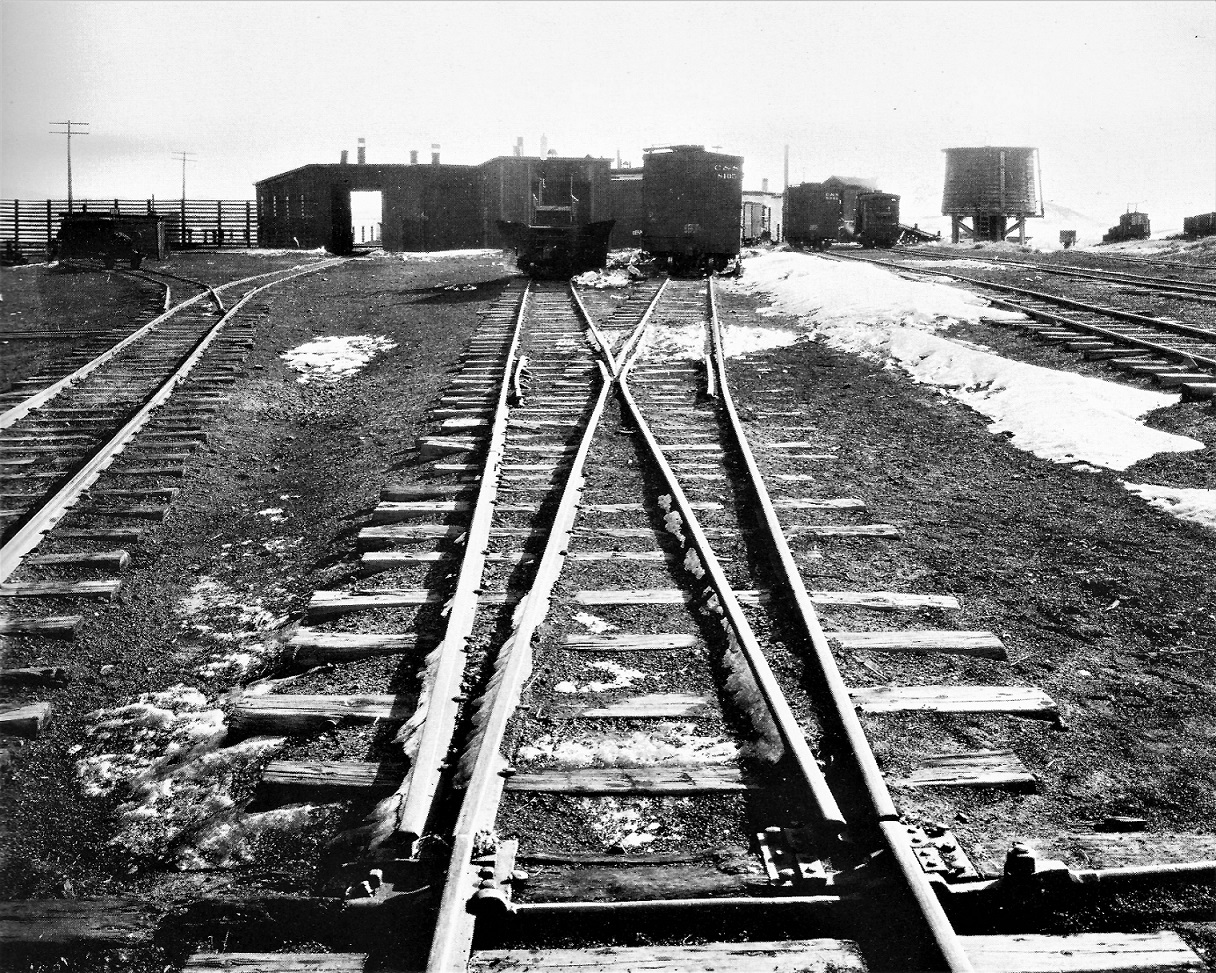 The wall to the left side runs at an angle toward the snow fence, and then angles toward the turntable. These are the windows that look very much like those from the Dickey Engine House. This addition also had six chimneys, and could well be the six that were at Dickey. You can see right through the stall, and it is clear that there were no doors on either end. The flanger (#015) sits on the track that leads to the rear door of the rotary stall. The space between the rotary stall and the open stall is closed on the end. When this burned, the rotary was facing the rear doors as was customary, #75 was resting nose first in the closed stall, and #72 was placed in the open stall, facing the turntable. All of the wood, including the entire sheathed body on the rotary was burned off. When the roof collapsed, #72's box style headlight (identical to that on #69), was destroyed and replaced with a much smaller Pyle headlight. Chris then responded: Jeff Ramsey related this about the Enginehouse: http://c-sng-discussion-forum.41377.n7.nabble.com/Help-dating-a-photo-of-Dickey-tp4645p4659.html Then yours truly (completely misunderstanding what Mike and Chris are talking about) felt compelled to opine in his usual wordy manner: Chris, I fear I'll have to disagree with you here. I doubt that the materials from the C&S Dickey engine house were used in Como. There is photographic evidence that the wood extensions to the Como roundhouse were in place during DL&G times, by the mid to late 1890s at the latest. Recall this beautiful photo that I believe Todd Hackett posted: 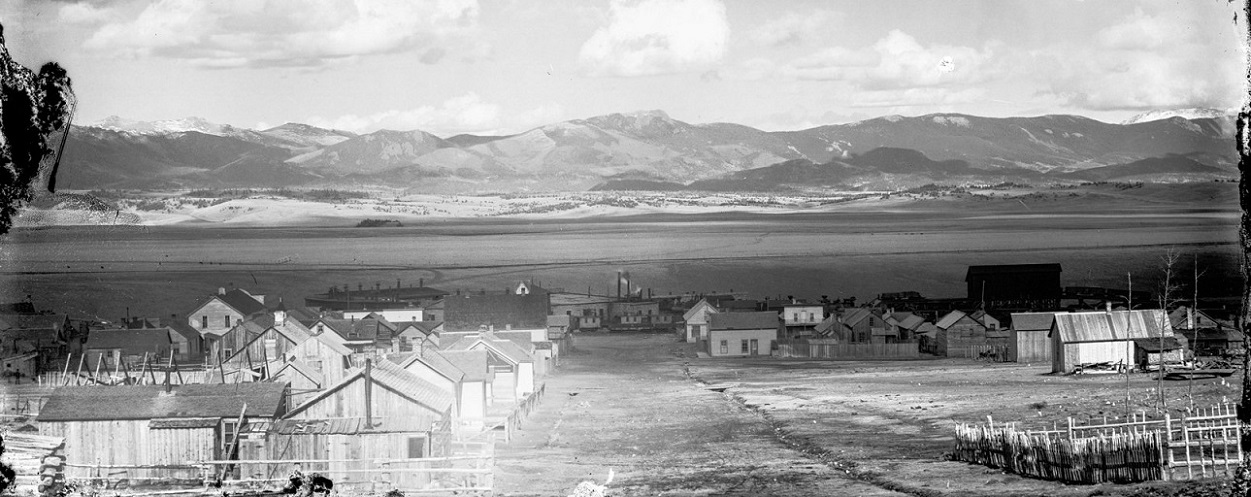 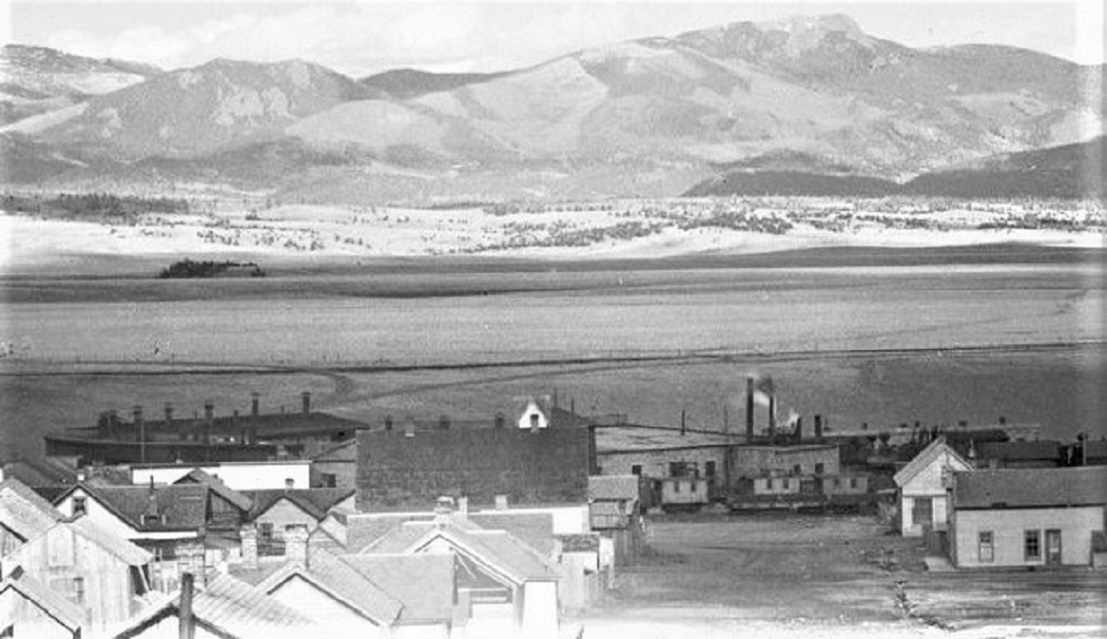 On enlargement, both diamond and McConnell stacked locomotives are present; the coal cars on the coal trestle and the boxcars hiding among buildings are lettered for the Union Pacific. And spotted just this side of the stone roundhouse are three cabooses in yellow DL&G / UP livery. Jeff Ramsey alluded to an early engine house at Dickey in the above link -- I've never seen written reference to it. Perhaps it was demolished and the materials thrown into the construction of the Como roundhouse extension. I'm not even sure when the 2 track engine house at Dickey was constructed. There are records of the coal chute being built in 1902, so I've assumed the engine house in Mike's Dickey was built about the same time, a C&S structure. That would have made Dickey a fully functional helper station, able to add helpers to both eastbound freights to Boreas and westbound freights headed up the Tenmile, and service the idle locomotives between runs. I've never seen a reference to when the C&S engine house at Dickey was taken down. If I were to guess, I'd say early teens. Beginning in 1909, the new CB&Q management was determined to rid itself of the South Park Divisions. Alpine tunnel was abandoned in the fall of 1910, and a significant washout of the Trout Creek line about the same time was used as an excuse to abandon Garos to Buena Vista. In the winter of 1910 the new Q management just stopped running trains over Boreas (last run October 31, 1910). Service returned for the summer months of 1911, but the line from Como to Breckenridge was not operated from the fall of 1911 until early 1913, when public and legal pressures forced the C&S to resume operations. During this 1910-1913 hiatus in Boreas operations, the C&S ran a daily passenger train from Leadville to Breckenridge, with a side trip from Dickey to Dillon. Freights were run as extras as needed. This is the only photo of this period showing a Leadville-Breckenridge passenger train along the Blue:  Otto Westerman photo in Kindig, et al., The Pictorial Supplement . . . Looks like one of the RPO-Coaches (40-43) and a coach in the two car consist behind number 61. I suspect that after 1910, C&S (CB&Q) management never saw the need for a helper station at Dickey ever again, and the engine house wasn't likely used as such. But it was still there as late as 1918, according the C&S Valuation Maps of that year (copy in "Files" section of main blog). So, Mikes date of disappearance of the early 1920's might well be right. I wasn't aware of an early (first) engine house at Dickey. Cliff Mestel's DSP&P / DL&G inventory doesn't show an engine house present between 1890 and 1895. More info anyone? I also added an additional photo: This is my favorite photo of the wood roundhouse extensions, from about 1906-1909:  C.O. David photo, in CRA Number 12, page 115. Seems to me that all the stalls have doors. Could it be that the "run-through" stalls were a later modification? Then, Mike schooled me about what was really being discussed: Jim, you are referring to the original very large wood roundhouse addition that was taken down in about 1910. What Chris and I are talking about is a second structure that may possibly have been partially a remnant of the large addition regarding the rotary stall and the adjacent stall. The pass through tracks were probably from the original large extension. Yard maps show pass through tracks during the time of the large wood stalls that almost enclosed the turntable. What we are discussing is the second and final structure that burned in 1935 and is pictured in the photo I included, and that you posted originally. That wall facing the depot and the chimneys could very well have been constructed from material scavenged from the "second" ( if it was) Engine House at Dickey. It really doesn't matter if there was one or two at Dickey, the one we have pictures of was taken down sometime after 1910 and before 1920. And Chris graciously responded to my post: By all means please disagree Jim, What I should have added was "on here" to my line, "I have read". I'm no expert on Como's Roundhouse, I was only going on what I read on here and I linked to Jeff's post once I found it, Jeff had also stated in another thread... "When the second boiler was placed in service is unknown but it was after 1886 but before 1896. This second boiler was most likely needed when the first wood additions was added to the roundhouse that were relocated or reclaimed engine houses from Platte Canon and Dickey and when the machine shop was expanded. This shop expansion occurred around 1893, same year as the DL&G West Denver roundhouse and machine shop were taken offline." in here: http://c-sng-discussion-forum.41377.n7.nabble.com/Como-Stationary-Boiler-tp4797p4842.html I was under a (mis-taken?) thought that there was mention elsewhere perhaps in a discussion (on here) about the Platte Canon, of which I haven't yet found. Stop Press. Jim Courtney wrote "In a typical Union Pacific management decision, the facilities here were deemed too efficient and were removed in 1893 or 1894, according to Derrell's article in the 2006 CNGQ. Derrell also speculated that an engine house might also have been located here, but I can't make one out. "; see here... http://c-sng-discussion-forum.41377.n7.nabble.com/Coal-and-Water-on-the-South-Park-tp1381p1452.html I had noted that I had seen the earliest pictures that I remembered showing the early wooden extensions, I'd also noted that a certain Otto Perry picture was dated before the Wooden extension fire showed an anomaly to my impression that the Wooden extension fire burned all that was shown in this picture, something I've never read to the contrary, at least I can remember. It was your inclusion of the 1929 C&S valuation train photo shown on pg83 in Mineral Belt V-II that jogged my intrigue, hence my "musings later this evening" signoff. 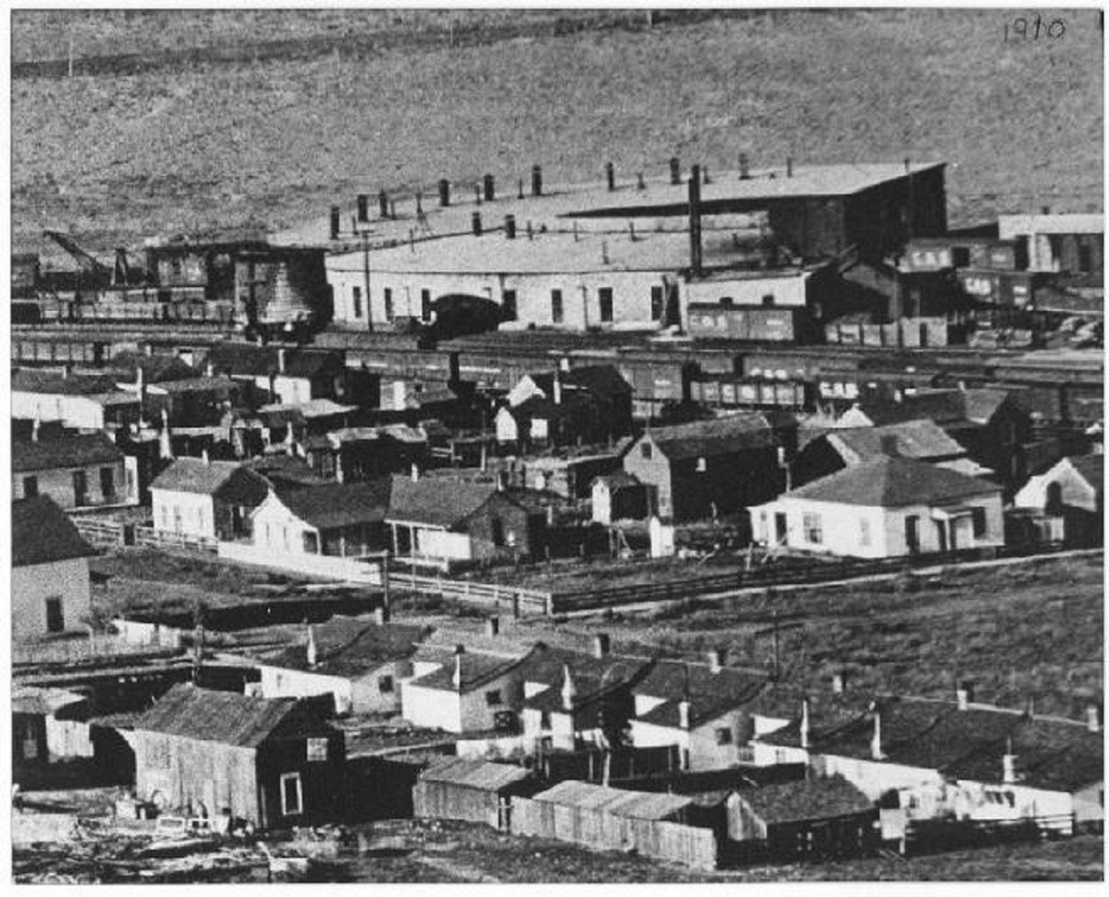 (sorry, this is my photo copy, not Chris's) Enlarged from: http://www.narrowgauge.org/ngc/graphics/excursion4/gkazel/dspp-gk-007.jpg Would someone who is of knowledge on this matter clarify how many Wooden stalls were standing prior the time of the fire, and anything they may know about the Demolition of the Wooden extensions, the part replaced by the snowfences behind the Boxcar bodies, prior to the downsized "through stalls" that burned in 1935. I would find it odd that there were enough Wooden stalls added in what appears to be two distinct additions to form a half circle, then be removed after the abandonment of Trout Pass, then again several new(or reclaimed) "run through" stalls added before being consumed in the '35 fire. As Mike has noted, there are Windows resembling the Enginehouse side at Dickey, bear in mind that there would have been no wall there since it was an internal edge to a Stall , the roof being supported by posts. This now Exterior wall would have needed to have been sheathed and windows inserted after the other unused stalls were razed. 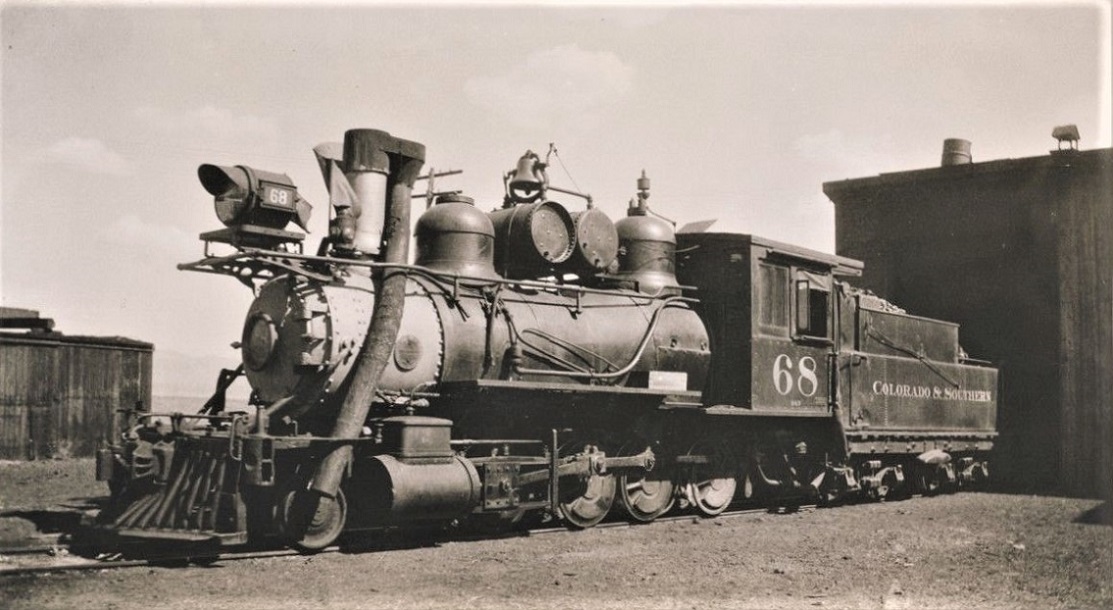 Lad G. Arend photo Dare I ask the question; did those come from the razing of the Dickey Enginehouse? If the C&S is that short of money to require demolishing a large portion of Wooden Roundhouse, would they spend money shifting another other than salvaging of the materials and window casings? Chris then posted two enlargements of DPL photos) http://digital.denverlibrary.org/cdm/fullbrowser/collection/p15330coll22/id/5109/rv/singleitem/rec/42 http://digital.denverlibrary.org/cdm/fullbrowser/collection/p15330coll22/id/5113/rv/singleitem/rec/43 During the Droste Como Depot war, I noted several posters/participants relating to the presence of but not posting, the existence of early Como images that may timeline this better. Again, does anyone else care to share? ___________________________________________________________ So there, Keith, the entire discussion (to date) is no longer "gronded" to Mike's scenery post. I have some more thoughts to add, but it's late and off to bed I go, as the Hospital calls tomorrow. 
Jim Courtney
Poulsbo, WA |
|
Administrator
|
Obviously we were typing at the same time Jim 😜
|
|
This post was updated on .
There is some sort of parallel universe thing going on here !!  I best get those missing enlargements in here that Jim missed above. 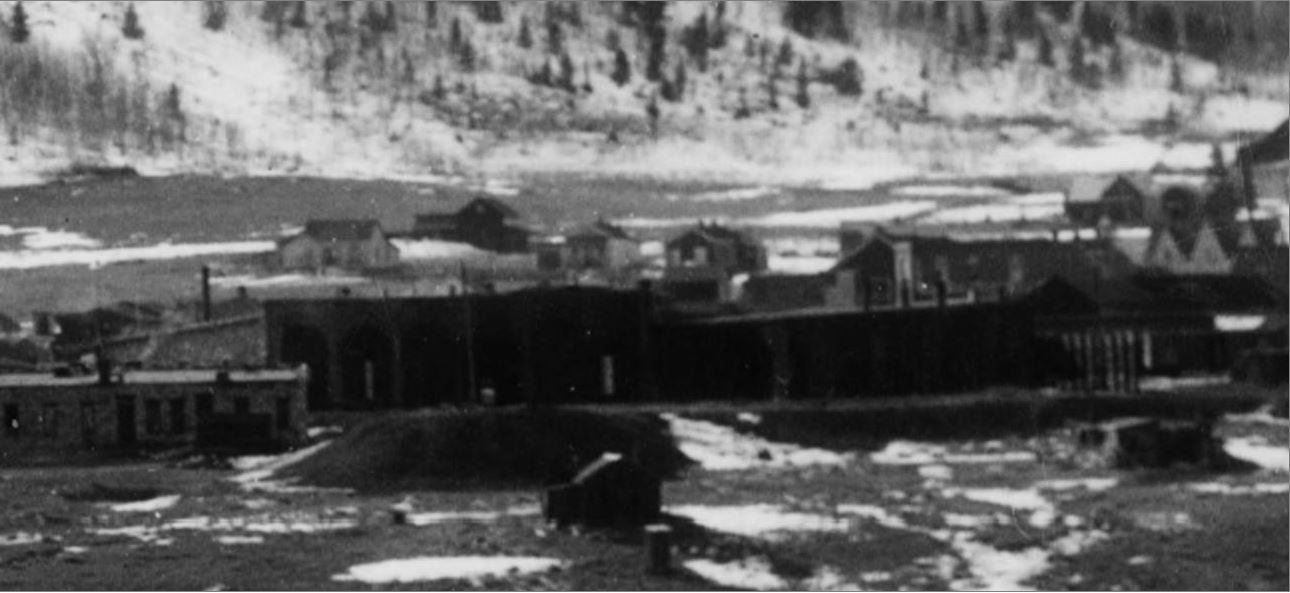 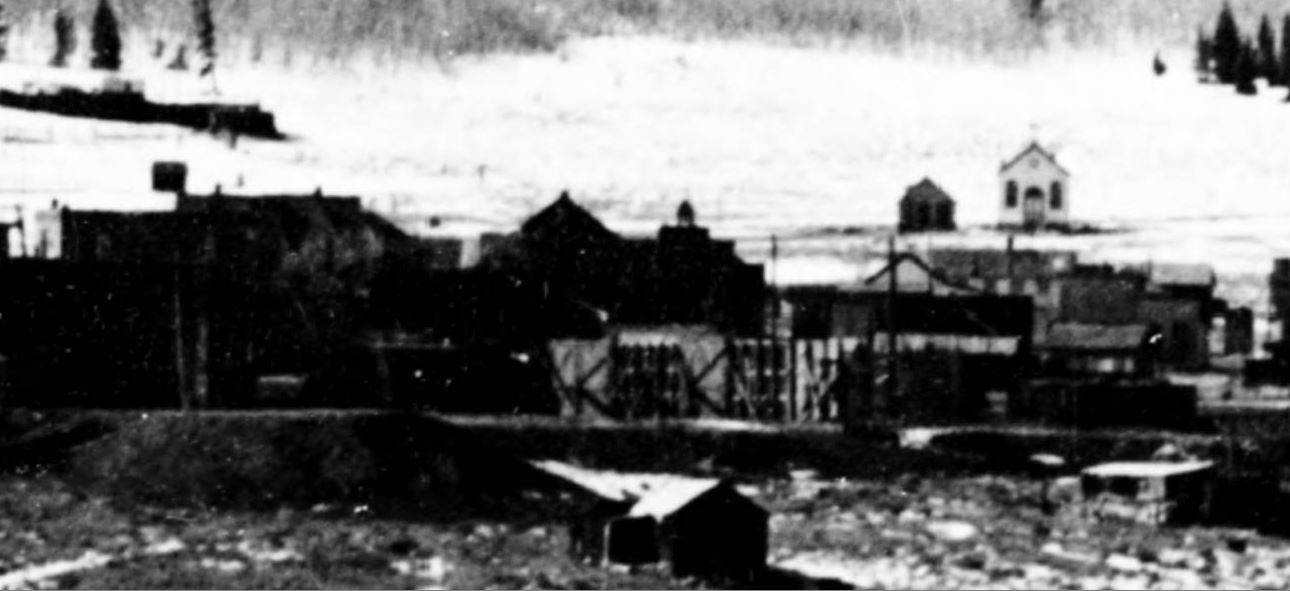
UpSideDownC
in New Zealand |
|
Administrator
|
Yes there is. The Blog and the Forum! While the Blog has been somewhat neglected with the advent of this forum, there remains allot of information posted by myself and other more credible (than me) authors. It also hosts the Files section of this Forum. A basic index of articles can be found here: C&Sn3 Index |
|
Administrator
|
Thanks for starting this thread, it should be easier to find later.
I'm not sure how much more can be added, but I do have at least one thing. In my series of meetings with Doug Schnarbush, he mentioned more than once this addition to the roundhouse. He had gone on the Extra Board in Como in 1927. His description was that although the rotary had a home there, the rest of the structure wasn't anything like a roundhouse at all, he thought of it as a drafty old shed, or an open barn. If you study the 1927 photo looking straight at the rear of the addition, bear in mind that you are looking straight toward the turntable, yet you are able to see enough of the long length of the North wall that you can easily count the windows. So you can imagine how different this is from normal roundhouse geometry. I've never been able to conjure up any reason why that odd addition is shaped like that, or why on Earth the third stall has no doors. I've seen a picture somewhere that shows the front corner of that open third stall, and it appears that the opening is just what you would expect as a roundhouse door. Jim Powers in Denver built this addition on to his On3 Como Roundhouse, and it was very interesting. Someone must have pictures of it, I'll write and ask him if he might. |
|
This post was updated on .
The premise of this thread is that the wooden extension of the Como roundhouse, in place by the late 1890s, was at some time in the 'teens or twenties, burned, demolished or other wise removed. Materials from the two-track, six-engine wood engine house at Dickey are hypothesized to have been used to build a new wood addition to the stone roundhouse at Como. This structure in turn burned in 1935.
I've gone back to my books and photos the last couple of days to see if the evolution of the Como round house can be further fine tuned. In the various books, photo captions, and posts on this forum, there is a lot of confusion with the terms "first addition, second addition, etc". I've tried to come up with a time line of structures at both Como and Dickey, to better sort this out. About 1880: The newly arrived DSP&P built the six stall stone roundhouse at Como, the structure that stands today. 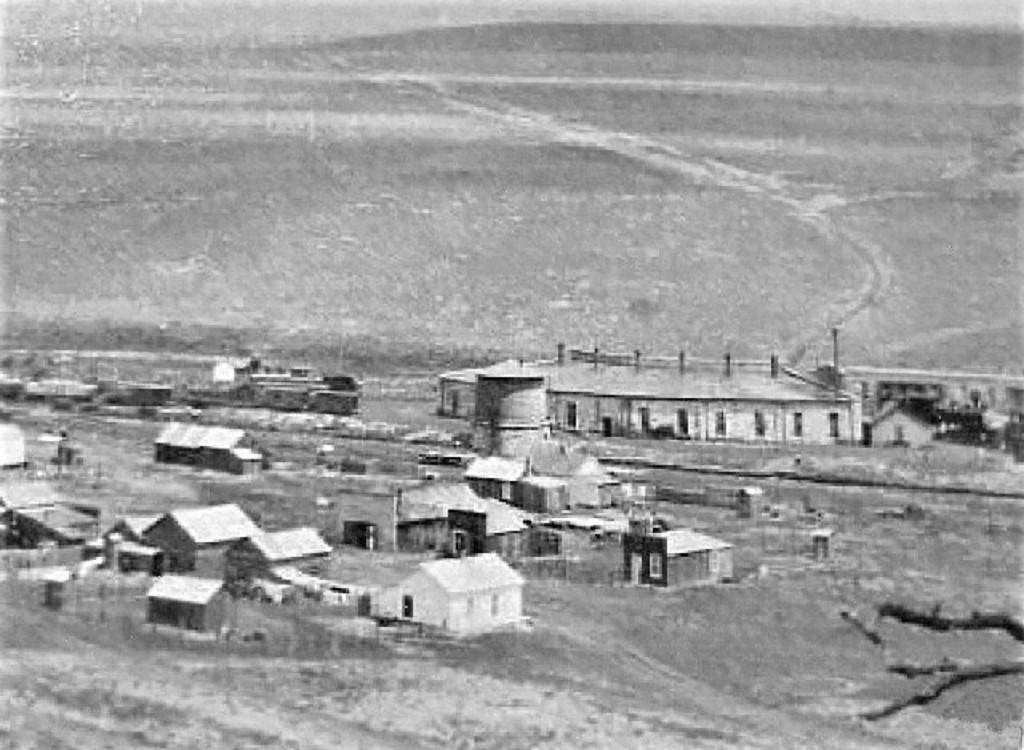 Circa 1883, Jeff Ramsey posted photo. Late 1880's: The first engine house was constructed at Dickey, unknown dimension, possibly to house the locomotive for the Keystone Branch mixed train. Late 1880s: A first wooden extension, unknown number of stalls, was added to the original stone roundhouse at Como. 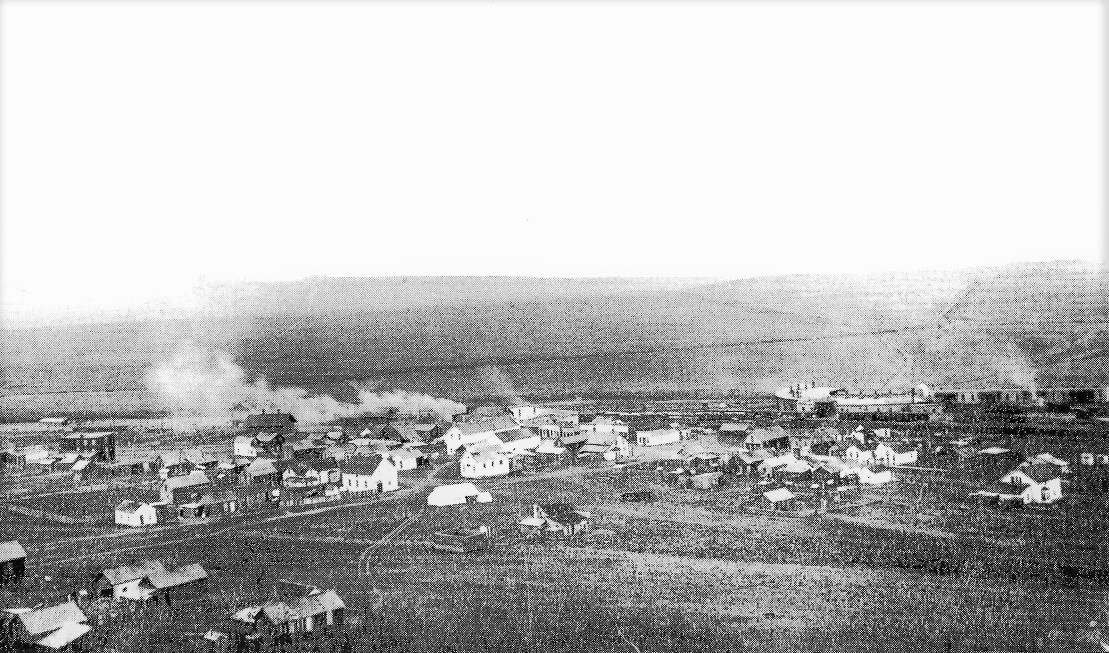 William Link Family, Tom Klinger collection, in C&S Highline Memories . . . This photo, dated 1892, shows the first wooden extension to the original stone Como roundhouse. Stone tenements are at right. Mid 1890s: A second wooden extension to the Como roundhouse was added, creating a semicircular structure totaling 19 stalls (6 stone, 13 wood). Service tracks eventually ran through up to three of the stalls, from depot to turntable. Jeff Ramsey cites the demolition of wood engine houses at Platte Canon (possibly Grants, if one actually existed there) and the first engine house at Dickey, the materials used in construction of this second extension. http://c-sng-discussion-forum.41377.n7.nabble.com/Como-Stationary-Boiler-td4797.html#a4842 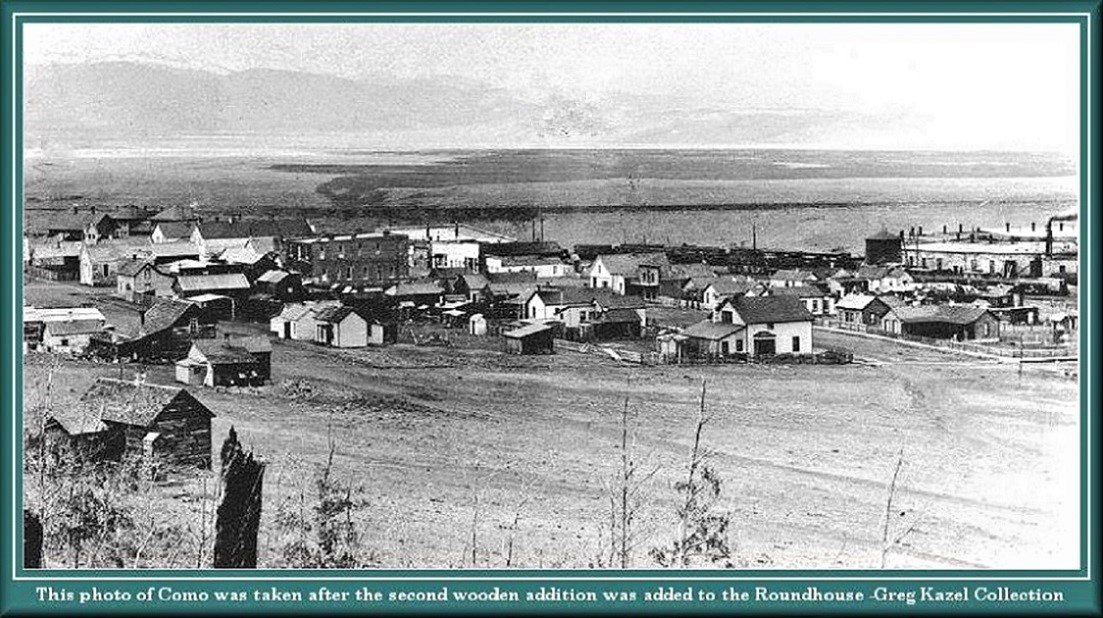 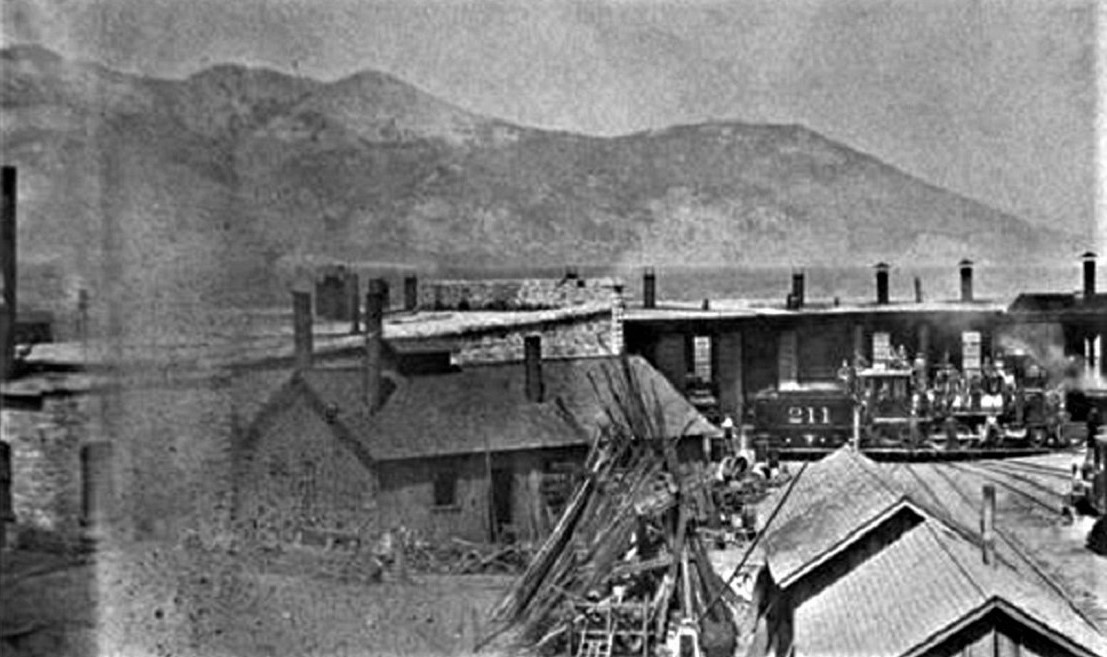 Jeff Ramsey posted photo, source unknown. A break in the roof pitch is visible in the first view, more obvious in the second photo, just over the stack of DL&G 211. 1902: At Dickey, the new C&S management builds the familiar two track engine house (see Darel's post at the top of this thread) and a twelve pocket coaling trestle with chutes serving two tracks (Mac Poor in Denver South Park and Pacific). Dickey is now a major helper station, for freights eastbound to Boreas and westbound up the Tenmile. 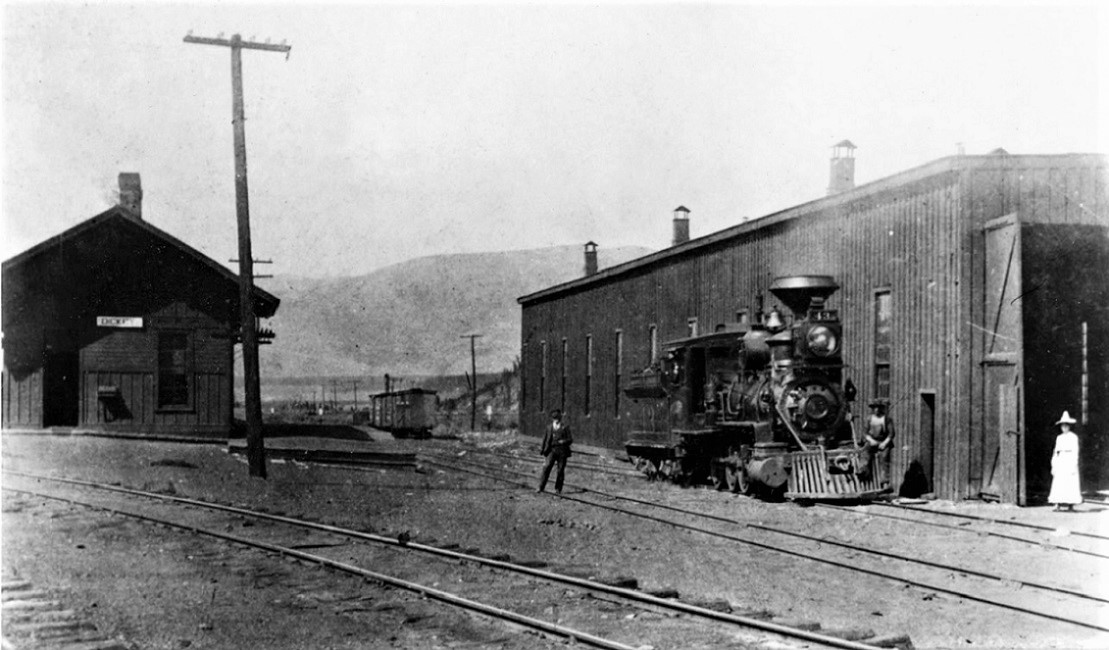 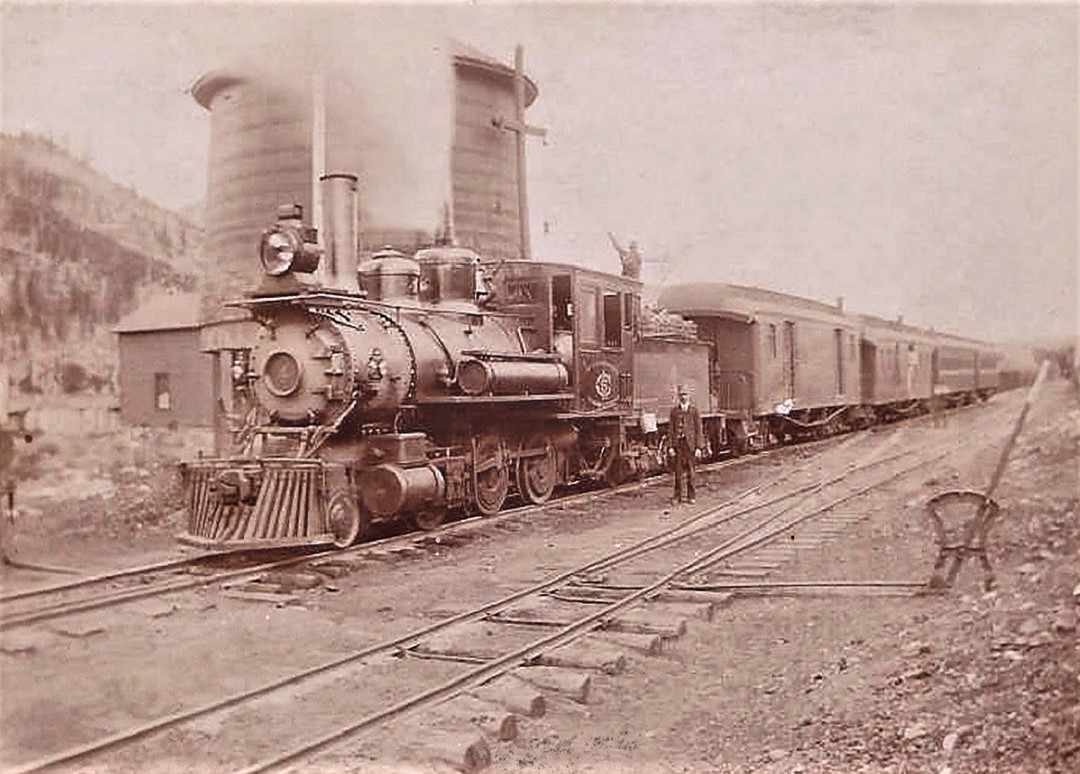 Coal chutes visible in distance at right frame. 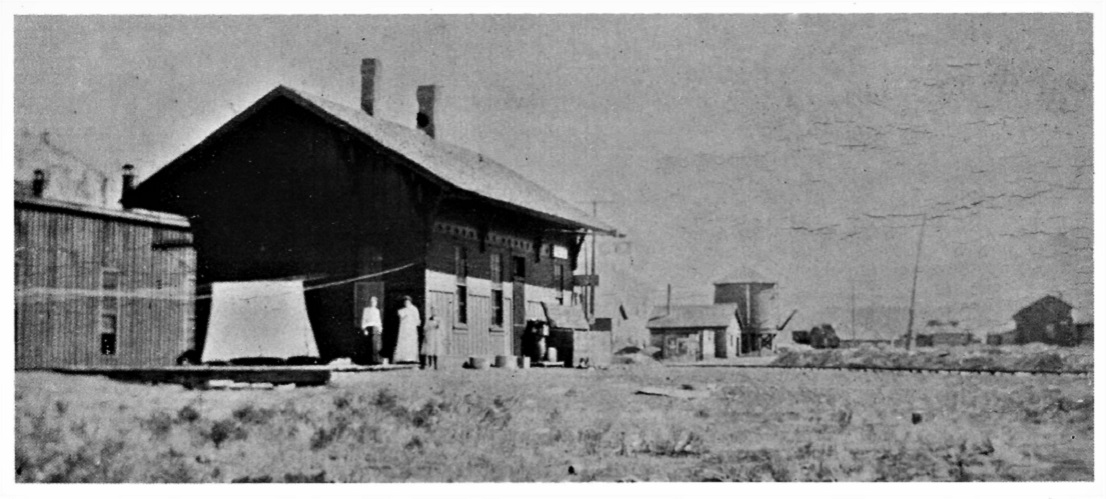 Ronzio collection, in Digerness, The Mineral Belt, Volume II. Dickey in the first decade, looking south. By 1906: The first and second Como wood roundhouse extensions have been remodeled with seamless new roof:  Fall 1910: C&S under new CB&Q management, abandons Gunnison extension beyond Hancock, Trout Creek line from Garos to Buena Vista, and closes operations over Boreas, Como to Breckenridge. The machine shops in the Como roundhouse were closed, the railroad work forced mostly transferred or discharged. Como as a community was devastated (total payrolls to Como in 1909 was $53,084.00; by 1911, total payroll $2,034.00). Fifty families remained in town in 1911 (hoping things would get better), falling to 12 families in 1912 (as things got worse). Early to mid 19teens: Even when Boreas operations resumed in 1913, the larger 2-8-0s (the Rhode Islands and the two large classes of Baldwins) that were freed up from the abandoned operations south of Garos were sufficient to handle the diminished traffic. In 1911, 14 of the 19 stalls in the Como roundhouse were storing dead engines, the lighter number 30 and thirteen of the Cooke 2-8-0s, "stored in white lead". The Dickey engine house had likely seen little use since the fall of 1910, but appears to be still there, though not visible in the only photo that I know of in that era, perhaps hidden by the pump house at right frame: 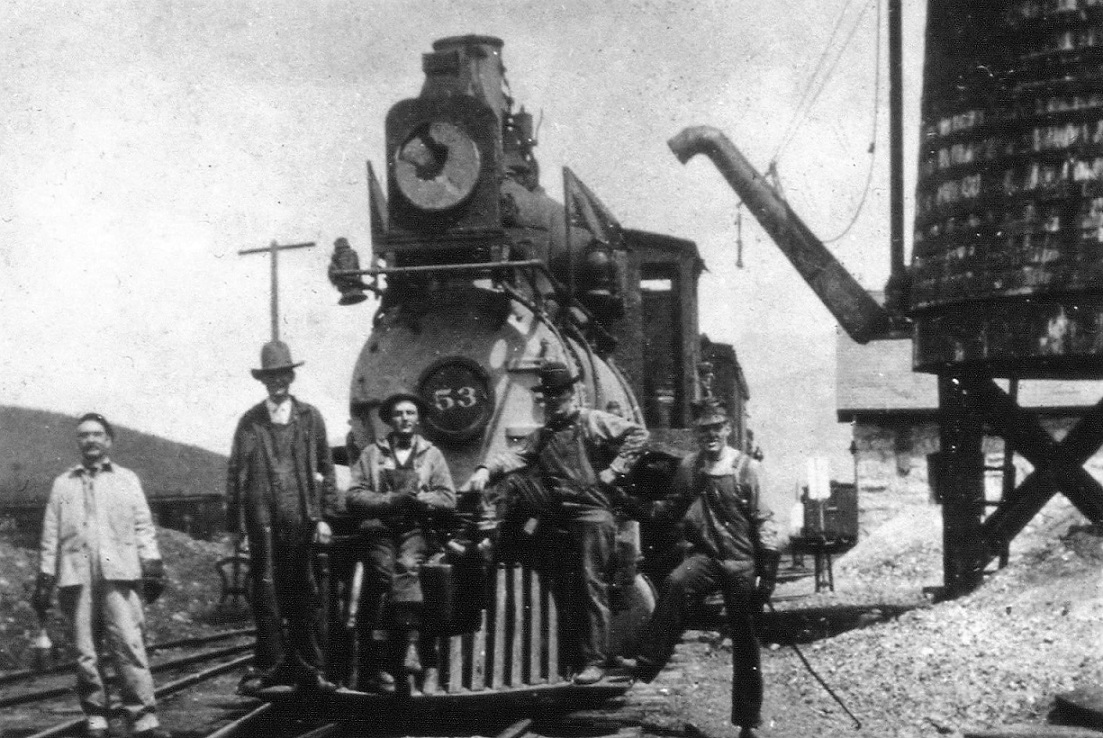 Summer of 1918: Per the 1918 C&S Valuation Maps, both the Dickey enginehouse and the Como roundhouse extension remain in place. See the reproduced map of Dickey that Risk Steele posted in the "Files" section. The Como map is below: 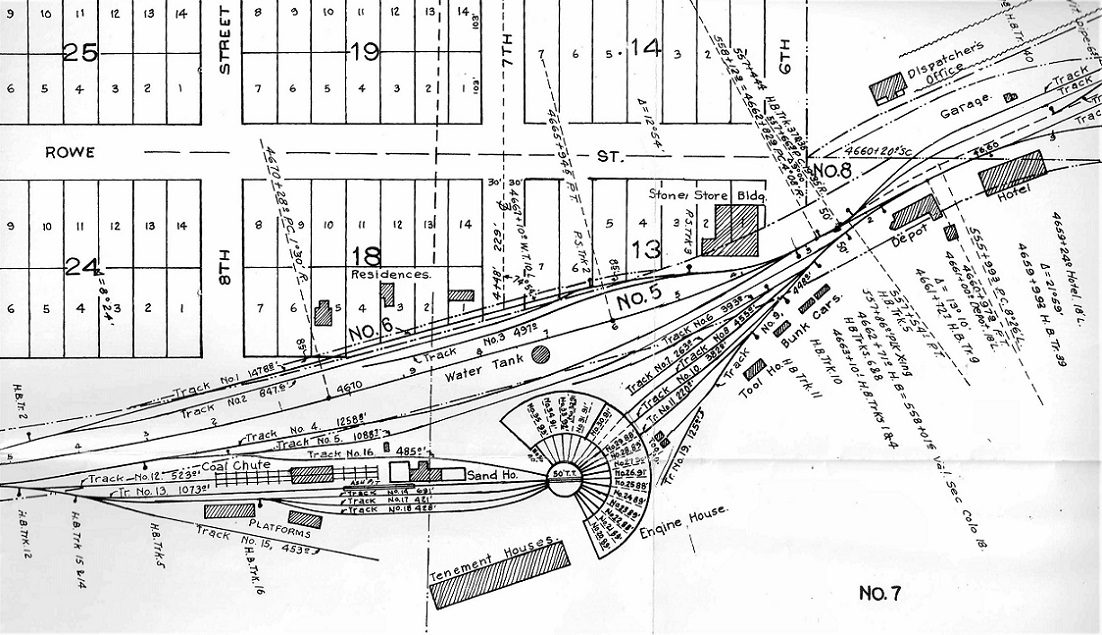 Between 1917 and 1920, four of the Cooke 2-8-0s (39, 45, 48 and 54) were pulled from their stalls in the Como roundhouse, hauled to Denver and sold to the Hallack & Howard Lumber Co. for use at their logging operations at La Madera, NM. 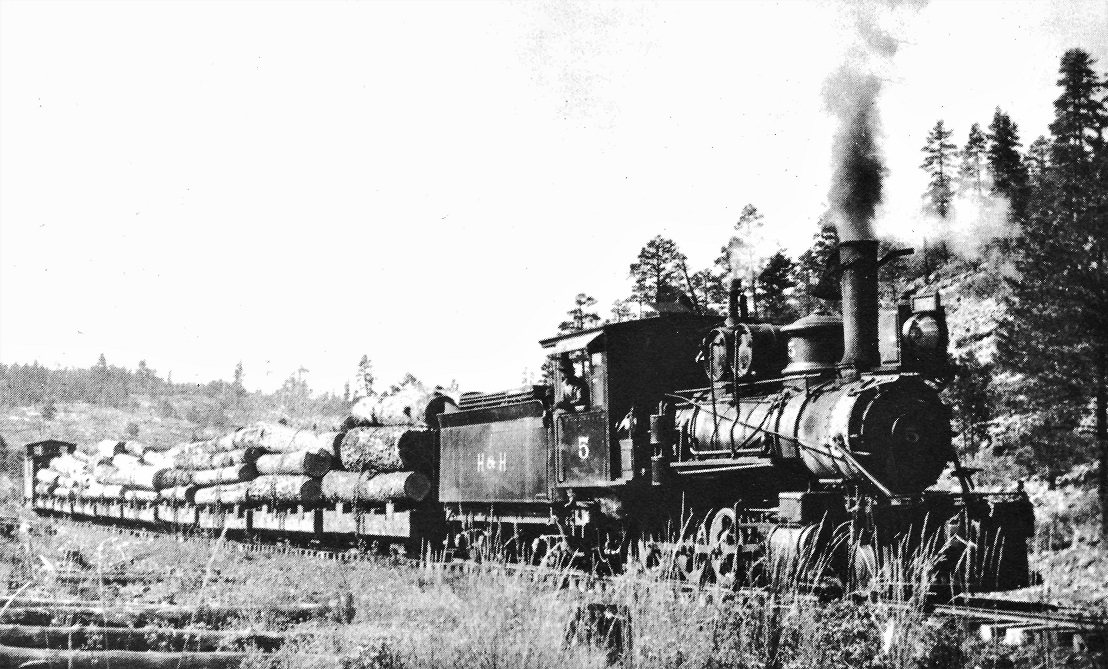 Ex C&S number 45 in 1921. W. J. Duteau photo in "Logging Along the Rio Grande". The Cooke 2-8-0 is back to work after a seven year slumber in one of the wood stalls of the Como roundhouse. Also in 1918, two more of the Como stored Cookes were scrapped (52 and 53) and Cooke 55 was hauled to Denver, refurbished and sold to the Bellevue and Cascade. 1920: Photo of wrecked number 67 shows the back wall of the wood roundhouse still in place.  In the Klingers' C&S Platte Canon Memories . . . 1921: In January, five of the remaining Como roundhouse stored locomotives (Cookes 42, 43, 47, 49 and 50) left Como to be traded to Morse Brothers in Denver for the three big Brookes locomotives, C&S 74, 75 and 76. Finally in the summer of 1921, the last two locomotives stored in the wood roundhouse (Balwin 30 and Cooke 40) were hauled to Denver for scrapping. Unknowns: I still haven't found any cited text to state when the Dickey engine house came down. Sometime between 1921 and the Denver Water Board Special of January 1929, the original wood roundhouse stalls were removed (burned, razed?) and a new, smaller ("third") wood extension to the stone roundhouse was built, as in the 1929 photo above. Or perhaps the original structure was truncated and remodeled? Were materials from the Dickey engine house, finally taken down, involved in this construction? It occurred to me that there was a major fire involving the stone tenement building, perhaps part or all of the original wood roundhouse went up with it or was damaged prompting demolition. I seem to recall a thread on this forum about the fire, but can't seem to locate it. I had thought the tenement to be completely destroyed, but another Denver Water Special photo in January, 1929, shows one end in ruins, the other still in use by the section foreman, John DeLeo and his brother: 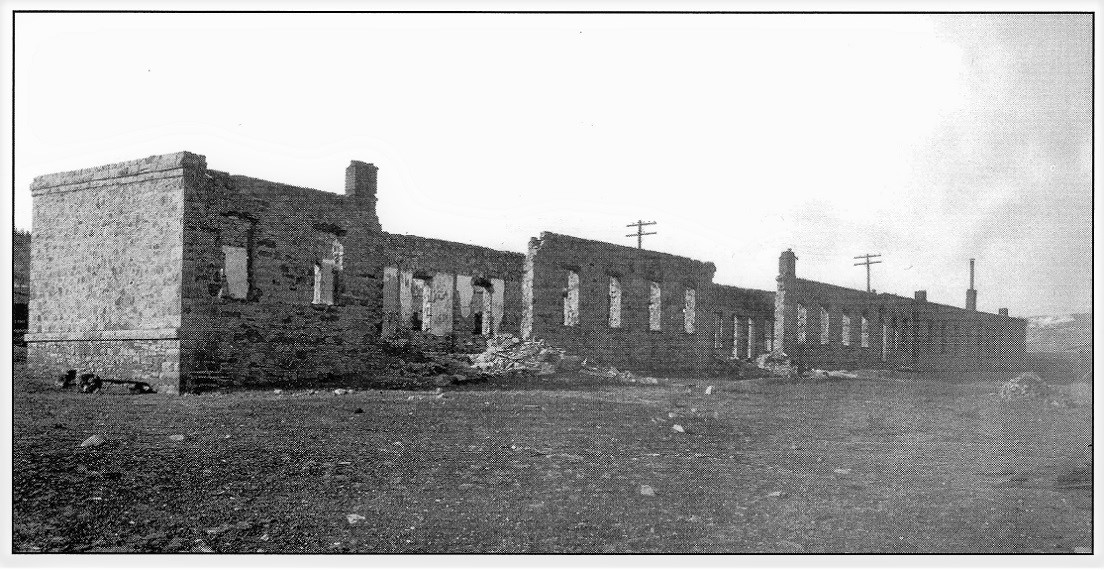 in the Klingers' C&S High Line Memories . . . 1935: The "third" wooden extension of the roundhouse burns, leaving the original six-stall stone roundhouse as the only building standing I'd love to see Jeff Ramsey comment here, correcting any of my misstatements. Anyone know of a floor plan for the "third" and final wood extension to the roundhouse?
Jim Courtney
Poulsbo, WA |
|
I remember the photo of the fire in the Tenements, it was tagged as being the Roundhouse, I would not have thought a fire there would impact the Roundhouse, some separation.
I have not found any written commentary. One of the Marinelli's was living in the end unit in the 1930's. |
|
Administrator
|
In reply to this post by Jim Courtney
Todd Hackett made a sketch of what we thought layout of the third addition must have been back in the 80's for what would have been built on my layout in Boulder. We were sure it had to be pretty close, based on measurements from the field, and the handful of photographs we could find that offered clues. Todd, if you can, would you post that here? I believe that was what Jim Powers used to build his rendering.
|
|
This post was updated on .
If you examine the Wooden first and second extensions pictures and compare with the CRRA #12 TT picture notice that the Stalls have been re-orientated for Loco's to "back in", opposite from the earlier "face in". Also examine my posted enlargement of the DPL Como panorama again, and compare the front wall on the odd shaped final wooden extension. Notice the height of the front of the wall and compare same with the Stone facade, seems to be same height as in the corresponding views of the 1st/2nd extensions.
EDIT: #112 should have read CRRA #12(having the book open with the picture of #112 didn't help) cross reference with the picture showing #211 on the TT with nosed-in Loco's. Also Jim, Klinger's South Park's Gunnison Division Memories...1920 dated picture of the #67 conflicts with the date given in Goin' Railroading pg143 which gives the Romley TT incident as 21st Feb 1918, the loco not recovered until Spring of 1918. On pg90 Digerness in Mineral Belt V-II states that "the engine shops were destroyed in 1909 and were never rebuilt." I guess that is erroneous and misleading and may have referred to the demise of the Blacksmith Shop/Boilerhouse, date unknown to me since the 1910 Como Pano in the http://www.narrowgauge.org/ngc/graphics/excursion4/gkazel/dspp-gk-007.jpg still shows the building standing. The Dickey Enginehouse had doubled Sash 4x3 Lights, the original Como Wooden extension show doubled Sash 4x2 Lights. This is fascinating, what Folly in pulling down the older extensions and putting something else back up in the same place within 10 years. Which is why I think the 1935 burned structure is just a reduction in Stalls and Rotary extended rework of what remained from the downsizing sometime in the twenties.
UpSideDownC
in New Zealand |
Re: Como Roundhouse Addition
|
In reply to this post by Darel Leedy
Look closely at the Link/Klinger photo and you can see the original section of the Gilman Hotel.
|
|
Would have been the Pacific Hotel in 1892.
Locos went in forward in later years backed in in early years. I have seen mention of the 1909 fire but nothing primary, the mentions i saw suggested it was a Town fire, bit no mention of what was involved, just assumed it was a misunderstanding. we have uncovered the inspection pits in Bay 8 and 10, I find it very hard to believe one bay was a pass though with no doors. Doors must have been replaced. |
I assume that you're speaking of the Original Stone Roundhouse ? I've seen the results of other Enginedriver's attempts to open the doors without leaving the Cab. 
UpSideDownC
in New Zealand |
|
In reply to this post by Mike Trent
I don't see it with my large drawings (it was actual size for O scale, so not so easy to post). I don't know that I ever brought it home from your basement. You may have given it to Jim Powers. This is what Greg Kazel came up with back in the mid-1980s from a survey we did. The water pipes, pit corners marked with letters, and other lettered points, were located from the center of the turntable pit. Everything else was sketched in based on those. The end walls of the last wood structure were based on what was visible from the angles we could find in photos. Notice how a lot of the pits don't line up with the turntable very well. 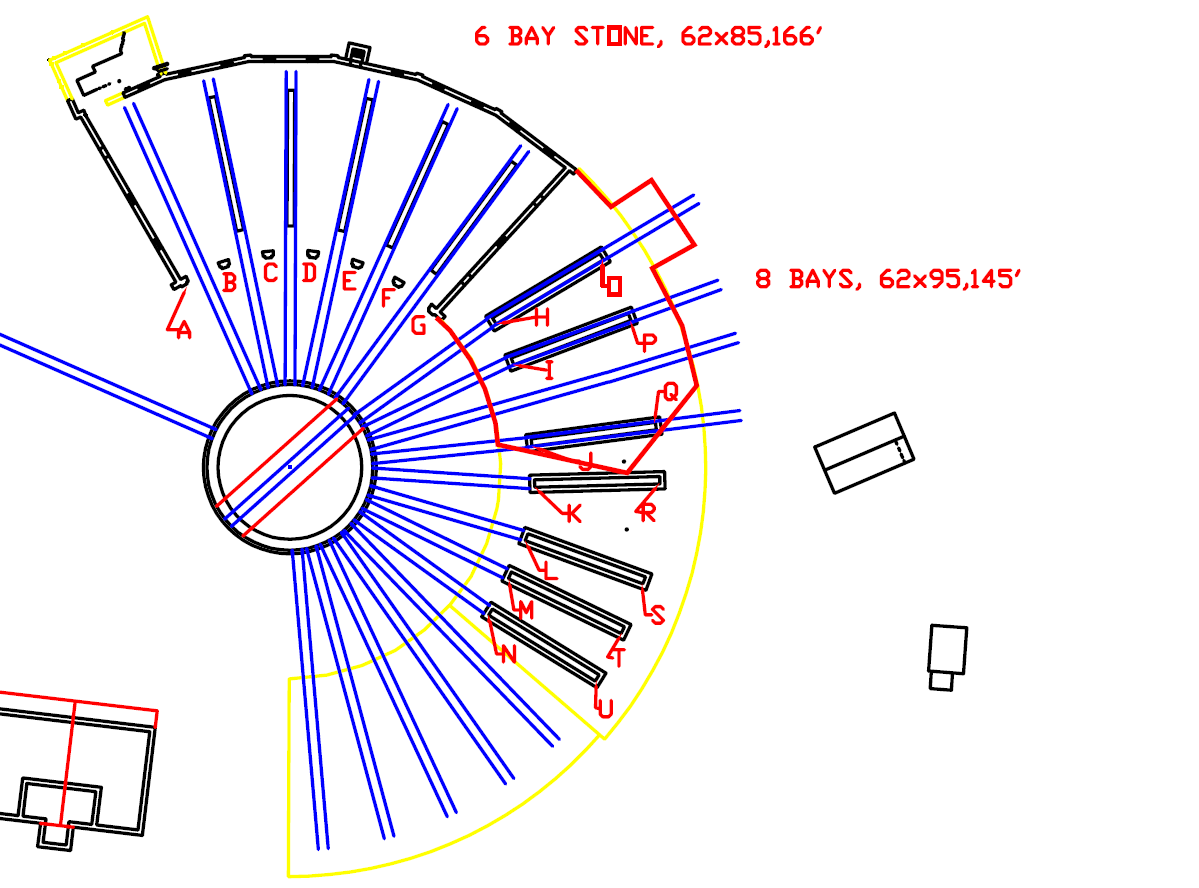
|
|
In reply to this post by Chris Walker
Yes the Stone section but appears the wooden section had the same orientation
The back of bay 5 seems like it was smacked at one time. |
Re: Como Roundhouse Addition--Greg Kazel Collection
|
This post was updated on .
In reply to this post by Robert McFarland
I've admired the 1910 Como photo in the link Chris gave to the Greg Kazel photo.
I've just now figured out how to get to the main directory and discovered more exquisite photos of the Como roundhouse area, some already posted, but far better images, some new to me: http://www.narrowgauge.org/ngc/graphics/excursion4/gkazel/dspp-gk-013.jpg 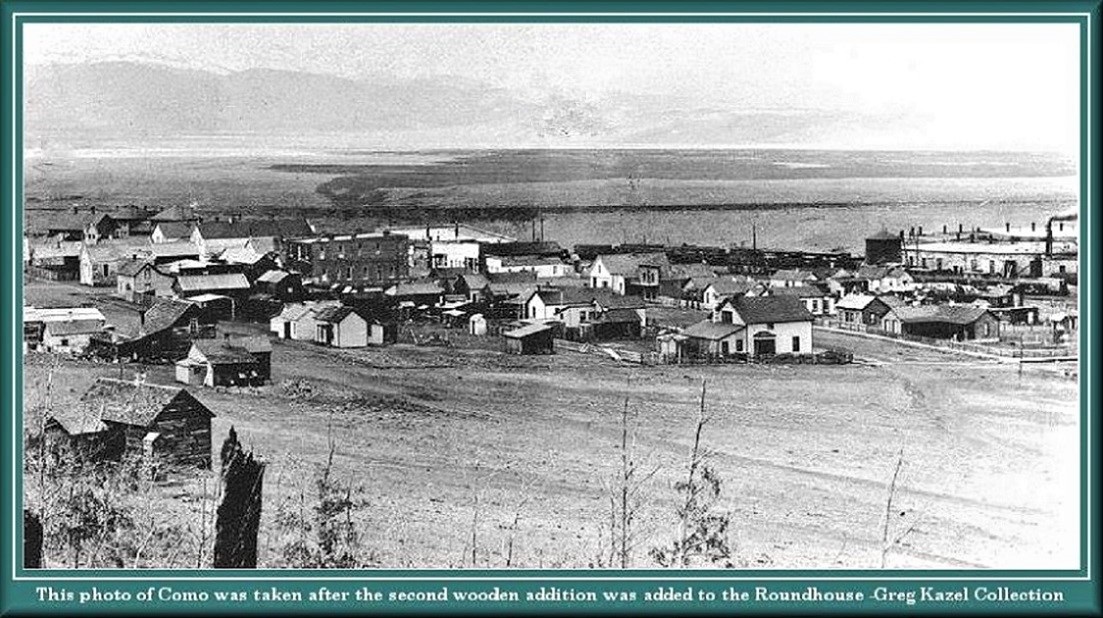 A clearer image of the one posted above. http://www.narrowgauge.org/ngc/graphics/excursion4/gkazel/dspp-gk-005.jpg 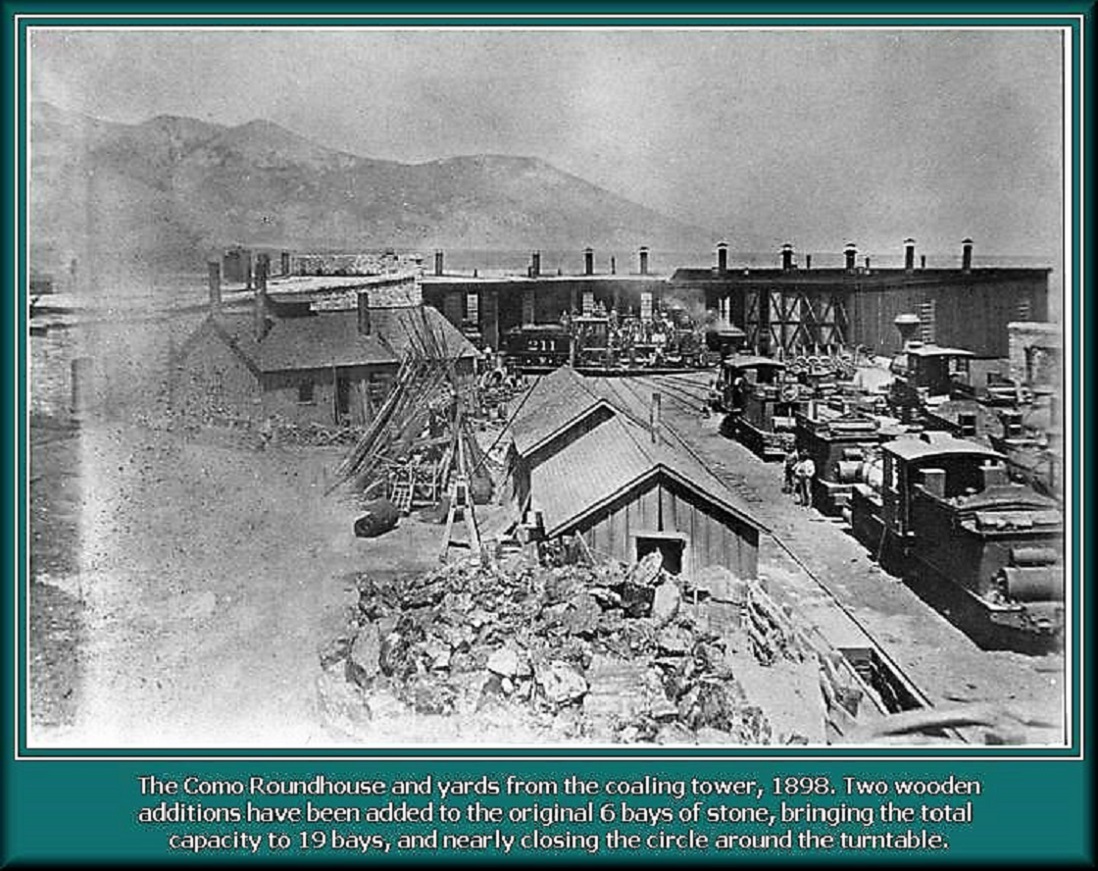 An uncropped, clearer image of the one posted in the timeline. The first and second sections of the wood roundhouse have doors of different height and design. http://www.narrowgauge.org/ngc/graphics/excursion4/gkazel/dspp-gk-025.jpg 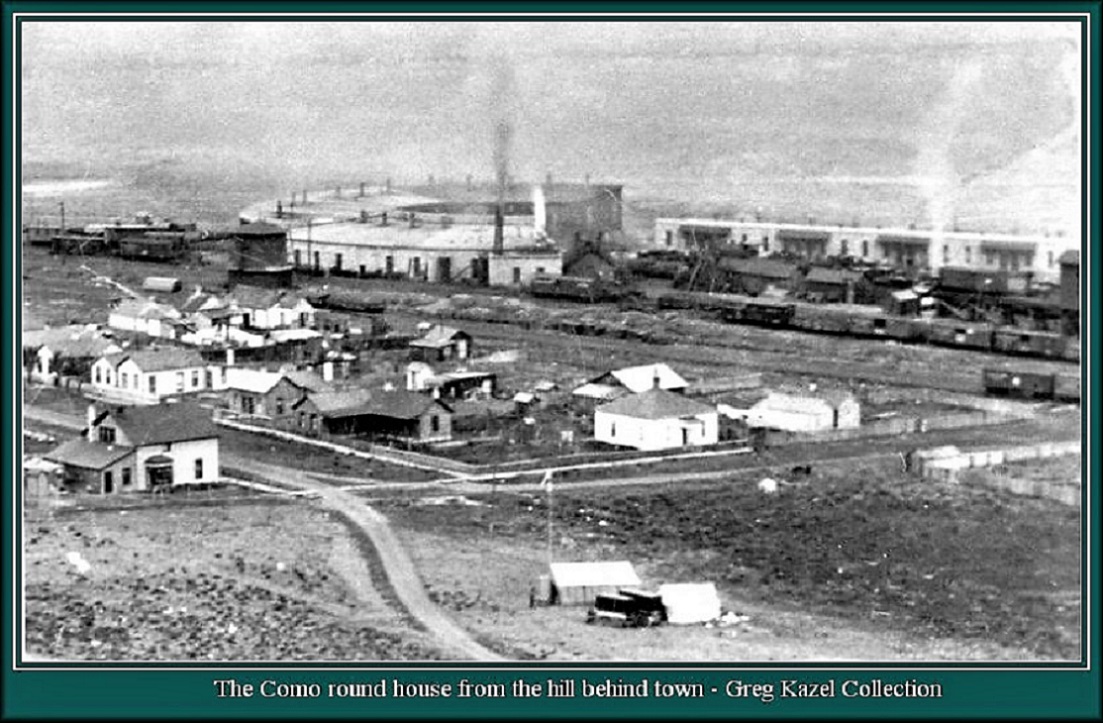 Late 1890s, pre-C&S, everything lettered for UP. Yellow way cars to left frame. Water tank still has enclosed base. The roofs of the three separate sections of the roundhouse are distinctly visible. The tenement building had a series of covered porches (who knew?). http://www.narrowgauge.org/ngc/graphics/excursion4/gkazel/dspp-gk-007.jpg 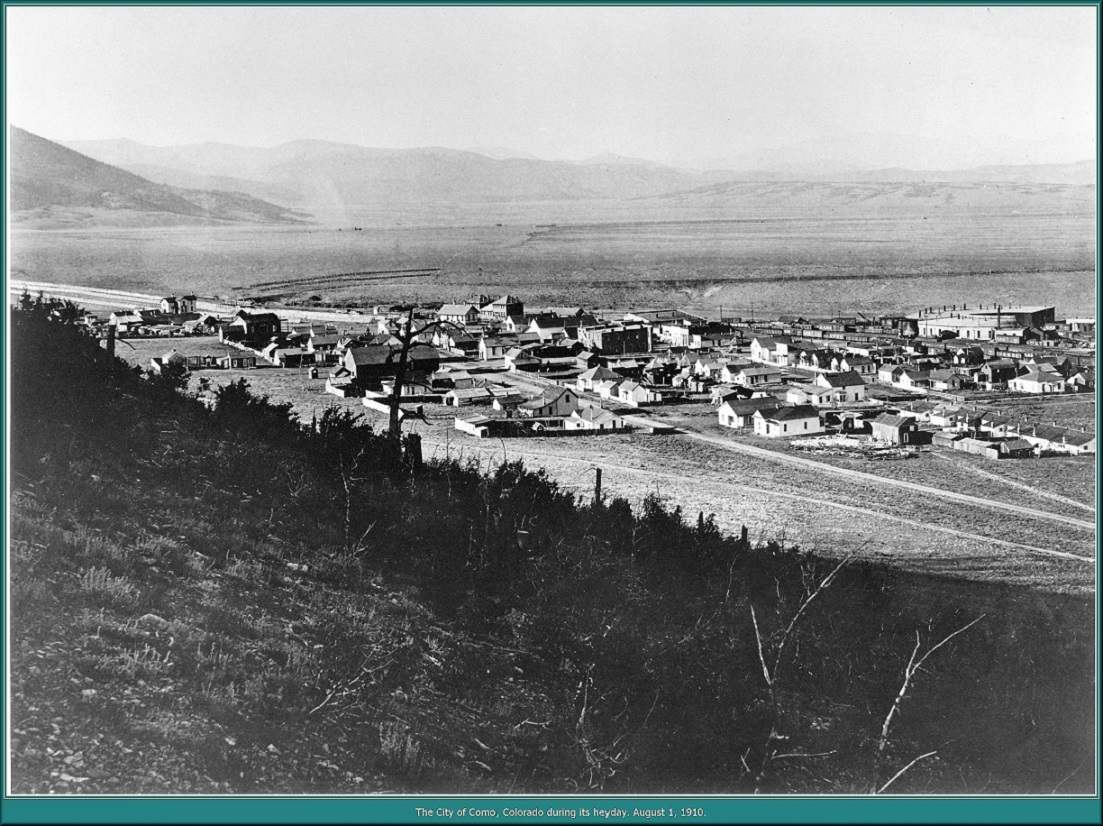 Beautiful photo of Como, only two months before the October, 1910, apocalypse. http://www.narrowgauge.org/ngc/graphics/excursion4/gkazel/dspp-gk-006.jpg  Proof that the full wood round house additions were still in place in 1919. Note that the tenement building hasn't yet burned. Note the eastbound freight train in the distance, near the wye. Not much activity at the roundhouse; the wood section is full of stored Cooke consolidations. http://www.narrowgauge.org/ngc/graphics/excursion4/gkazel/dspp-gk-016.jpg 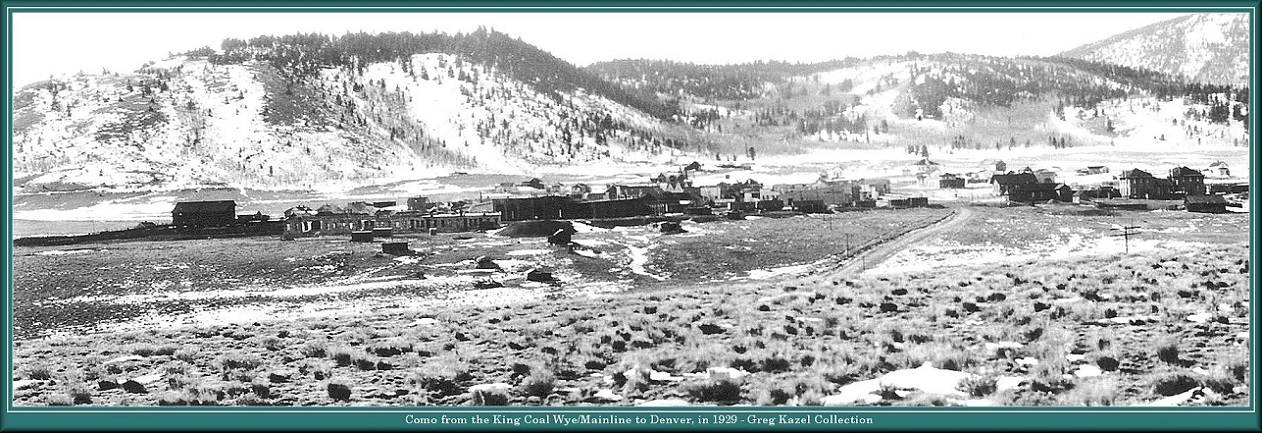 One of the clearest images of the 1929 DWB special overview of Como, that I've seen.
Jim Courtney
Poulsbo, WA |
|
Administrator
|
This post was updated on .
In reply to this post by Chris Walker
Chris, yes, Klinger's date is incorrect, as Sam Speas himself was on the engine when it wrecked on February 21, 1918, he would know, and the accompanying photos and text attest to the date explicitly. Sam said the engine spent several months there before it was recovered.
As you point out, when the last addition was made, it probably included the long addition at the rear to the first stall for the rotary, and track was realigned to make it work, as the original addition did not have a pass through stall adjacent to the stone wall. Check the drawing. The second stall of the last addition featured a blank wall, which is where I believe the wrecked #67 is in the photo. The third "stall" in the later addition was where the open pass through is just behind the #67 in the photo. Clearly, there are two rear walls of adjacent stalls beyond that one. As always, every picture tells a story. This story here represents, again, just how dangerous railroading can be, both then, and now. |
|
I seem to recollect there were 2 Rotary's in Como at one time.
Having an open pass through facing North, well that would be a nightmare in the winter. From a practical point of view that seems unlikely. |
|
Administrator
|
Actually, the C&S only had two Rotarys.
The larger #99201 was used mostly along the front range for most of it's life, and was eventually set on narrow gauge wheelsets in later days, then was reconverted to Standard gauge in 1943. After the 1935 fire, #99200 recieved a new steel sheathed body, and a sloped back tender. It was eventually scrapped when the wheel shaft broke. They could have kept both in Como, but I agree it would have been impractical. One was probably in the weeds in Denver most of the time. looking at the old #99201 at the CRRM now, it's hard to imagine it being used on the narrow gauge at all, but it sure was. |
«
Return to C&Sng Discussion Forum
|
1 view|%1 views
| Free forum by Nabble | Edit this page |

